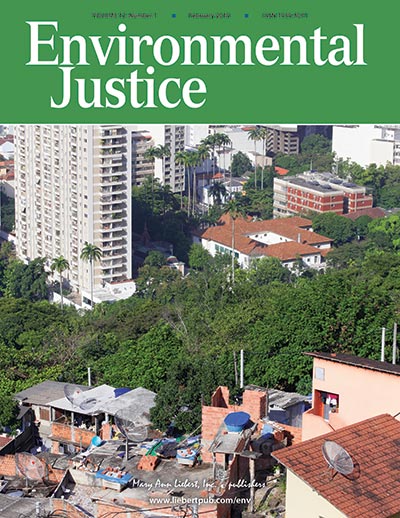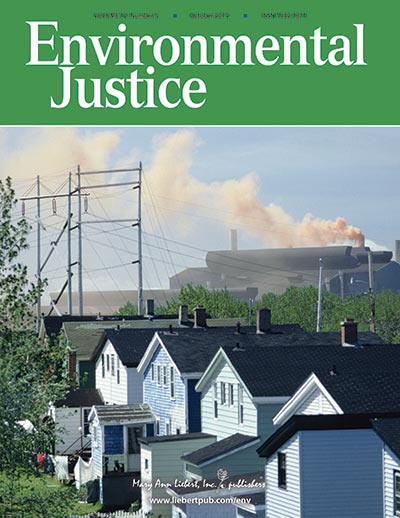Image: © Environmental Justice Institute Covid regime (in Foucault's meaning) After February 26, 2020 when the first Corona wave hit Germany, the Environmental Justice Institute fell into deep slumber but is awakening in face of a supposed end in sight. A key issue with the Corona pandemic is rooted in the regime (in [...] | Image: © Mary Ann Liebert, Inc. Highly cited and featured articles of the journal Environmental Justice available Once again, the journal Environmental Justice (jEJ) provides access to a number of articles that were selected either due to their impact factor in the field of enviromental justice research. The jEJ is one of the most relevant pioneers in the [...] | Image: © Mary Ann Liebert, Inc. Most downloaded articles of the journal Environmental Justice available The journal Environmental Justice (jEJ) is one of the most relevant pioneers in the field of Environmental Justice Research. The peer-review journal is published bimonthly, covering the impacts and environmental burdens that affect marginalized po [...] |
Image: © KEITI and Kaufmann Environmental Justice in South Korea Approached by Dr. Jeong-Hi Go from Thirdspace Berlin who kindly served also as perfect translator between the two languages, the Environmental Justice Institute (EJI) convened with chief researcher Won Hui Cho and researcher Jae Ho Im from the [...] | Image: © Rosignoli Environmental Justice Workshop in Italy On December 17, 2019, the workshop "Environmental Justice in a comparative perspective" took place at the University of Milan, "La Statale."(Download the program including names of participants here) The event took place at the Department of International, Legal, Historical and Political Studies [...] | Image: © Mary Ann Liebert, Inc. Organizing for dealing with Climate Change The journal Environmental Justice (jEJ) is one of the most relevant pioneers in the field of Environmental Justice Research. The peer-review journal is published bimonthly, covering the impacts and environmental burdens that affect marginalized po [...] |
|
Justice Environnementale comme thème de recherche
Considérations théoriques sur la justice environnementale en tant que cadre de recherche
Par Götz Kaufmann, October 6, 2014, traduit par
Marie Courtais, April 20, 2018
La justice environnementale est composée de plusieurs notions
complémentaires (Bolte, G., Bunge, C., Hornberg, C., Köckler, H., Mielck, 2012, Maschewsky, 2001, Walker, 2009). De manière simple, il s'agit des concepts de bénéfices environnementaux, de nuisances environnementales et de risques environnementaux (Kaufmann, 2013a, p.167).
Au plan institutionnel, il existe une ébauche de reconnaissance grâce aux débats survenus aux États-Unis et au Canada dans les années 80, autrement dit aux allégations de justice environnementale et de racisme environnemental (Gosine & Teelucksingh, 2008), situant dans l'histoire le début des luttes pour la justice environnementale après l'incident de Love Channel (voir Dobsen, 1998, TH Fletcher, 2003, T. Fletcher, 2002) et les manifestations contre l'implantation illégale de décharges dans le Warren County (RD Bullard, 1993, R. Bullard, 1993, Chavis et Lee, 1987). Les études en justice environnementale analysent non seulement les groupes marginalisés dûs à des critères raciaux ou ethniques (personnes d'origines amérindiennes, indigènes, afro-américaines ou encore aborigènes, etc.), mais aussi les divisions de genres (Souza, 2008). Du fait de l'histoire du mouvement (Gosine et Teelucksingh, 2008), la recherche en justice environnementale suit une logique «ascendante» - elle se concentre à l'échelle communautaire (Kameri-Mbote & Cullet, 1996) et le concept d'«environnement» répond à la définition d'un endroit où nous «vivons, agissons et jouons» (Gosine & Teelucksingh, 2008, p. VIII). En ce qui concerne la notion de justice, le concept traite autant de la justice distributive, intergénérationnelle que procédurale. En ayant une orientation «citoyenne», le domaine de recherche en justice environnementale se rapproche des études culturelles, mais est aussi relié aux études sur les inégalités, le genre, |
|
|
|
l'organisation sociétale, l'économie, l'éthique, la philosophie, la sociologie et la politique (entre autres).
En tant que cadre général de recherche, la justice environnementale fait référence au racisme environnemental en termes de probabilités statistiques de confrontation aux impacts négatifs dans un environnement donné (Beck, 1986, entre autres).
Il est important de distinguer deux réponses existantes à la manifestation d'une distribution inégale des biens et des nuisances environnementales. L'une d'entre elles s'appelle la revendication «Pas-dans-mon-arrière-cour» (NIMBY pour «Not-In-My-Backyard»), qui remonte aux débuts du mouvement, lorsque des communautés afro-américaines exigèrent le remplacement des sites de décharge qui menaçaient leur voisinage. La seconde est plus critique et contraint «Dans-l'arrière-cour-de-personne» (NIABY pour «Not-In-Anyone's-Backyard») (voir Maantay, 2001). D'après cette dernière revendication, la solution doit inclure les préoccupations de la société dans son ensemble. La justice environnementale ajoute la communauté dans la recherche environnementale en tant qu'acteur indépendant et incorpore les questions de justice sociale dans ce champ d'études (Kameri-Mbote & Cullet, 1996). |
De la structuration de la recherche s'est ajouté le concept de polyrationalité (Davy, 2008) pour exprimer les différences de perceptions des communautés quant aux environnements de résidence.
En sociologie, la recherche en justice environnementale est inhérente à la construction sociale du concept d'environnement. Cela nous amène à la conclusion que les problèmes environnementaux ne se posent que lorsque la communauté concernée les perçoit comme tels ou en tant que concept de «nature sociale» (voir Kaufmann, 2013b).
Les sciences politiques mettent l'accent sur les droits à l’égalité de participation dans le processus de construction de l'opinion publique (Maguire & Lind, 2003) alors que les études de droit et de philosophie examinent les différents champs de conception de la justice (Rawls, 1972; Schmidtz, 2007). Toutes ces approches, de manière égale, définissent la justice environnementale comme un domaine de recherche et d'activité transdisciplinaire fertile.
Pour sa part, l'Environmental Justice Institute a été fondé dans le but de soutenir les efforts communs de la société et du domaine académique déjà existants au plan international, ainsi que pour encadrer le concept de justice environnementale et réunir des personnes de différentes disciplines et horizons. |
|
|
Références
Beck, U. (1986). Risikogesellschaft. Auf dem Weg in eine andere Moderne. Frankfurt am Main.
Bolte, G., Bunge, C., Hornberg, C., Köckler, H., Mielck, A. (2012). Umweltgerechtigkeit. Chancengleichheit bei Umwelt und Gesundheit: Konzepte, Datenlage und Handlungsperspektiven. (A. Mielck, Ed.) (1st ed.). Bern: Verlag Hans Huber.
Bullard, R. (1993). Anatomy of Environmental Racism and the Environmental Justice Movement. In Confronting Environmental Racism.
Voices from the Grassroots (pp. 15–40). Cambridge: South End Press.
Bullard, R. D. (1993). Confronting Environmental Racism. Voices from the Grassroots. Cambridge.
Chavis, B., & Lee, C. (1987). Toxic Wastes and Race in the United States. A National Report on the Racial and Socio-Economic Characteristics of Communities with Hazardous Waste Sites (p. 86). New York. Retrieved from http://www.ucc.org/about-us/archives/pdfs/toxwrace87.pdf on 11/07/2015.
Davy, B. (2008). Plan it without a condom! Planning Theory, 7(3), 301–317. Retrieved from http://plt.sagepub.com/content/7/3/301.full.pdf+html on 11/07/2015.
Dobsen, A. (1998). Justice and the Environment, Conceptions of Environmental Sustainability and Theories of Distributive Justice. Oxford.
Fletcher, T. (2002). Neighbourhood change at Love Chanal. Contamination, evacuation, and resettlement. Land Use Policy, 19(4), 311–323.
Fletcher, T. H. (2003). From Love Canal to Environmental Justice. The Politics of Havardous Waste on the Canada-U.S. Border (p. 239).
Gosine, A., & Teelucksingh, C. (2008). Environmental Justice and Racism in Canada: An Introduction (p. 153). Toronto: Edmond Montgomery Publications Limited.
Kameri-Mbote, P., & Cullet, P. (1996). Environmental Justice and Sustainable Development. Integrating Local Communities in Environmental Management (No. 1996-1) (p. 12). Retrieved from www.ielrc.org/content/w9601.pdf on 11/07/2015.
Kaufmann, G. F. (2013a). Environmental Justice and Sustainable Development. With a case study in Brazil's Amazon using Q Methodology (3rd ed., p. 424). Saarbrücken: Südwestdeutscher Verlag für Hochschulschriften. Can be retrieved from Google Books (checked 11/07/2015).
Kaufmann, G. F. (2013b). From imaginary problem of "pollution" of a "clean" earth to the concept of "Social Nature." In Environmental Justice and
Sustainable Development. With a case study in Brazil's Amazon using Q Methodology (pp. 38–40). Saarbrücken: Südwestdeutscher Verlag für Hochschulschriften. Can be retrieved from Google Books (checked 11/07/2015).
Maantay, J. (2001). Zoning, Equity, and Public Health. American Journal of Public Health, 91(7), 1033–1041. Retrieved from http://ajph.aphapublications.org/doi/pdf/10.2105/AJPH.91.7.1033 on 11/07/2015.
Maguire, L. A., & Lind, E. A. (2003). Public participation in environmental decisions stakeholders, authorities and procedural justice.
International Journal of Global Environmental, 3(2), 133–148.
Maschewsky, W. (2001). Umweltgerechtigkeit, Public Health und soziale Stadt. Frankfurt am Main: Verlag für Akademische Schriften.
Rawls, J. (1972). A Theory of Justice. Oxford: Clarendon Press.
Schmidtz, D. (2007). Elements of Justice (p. 243). Cambridge, New York, Melbourne, Madrid, Cape Town, Singapore, Sao Paulo, Delhi, Dubai, Tokyo, Mexico City.
Souza, A. (2008). The Gathering Momentum for Environmental Justice in Brazil. Environmental Justice, 1(4), 183–188.
Walker, G. (2009). Beyond Distribution and Proximity. Exploring the Multiple Spatialities of Environmental Justice. Antipode, 41(4), 614–636.
|
||




